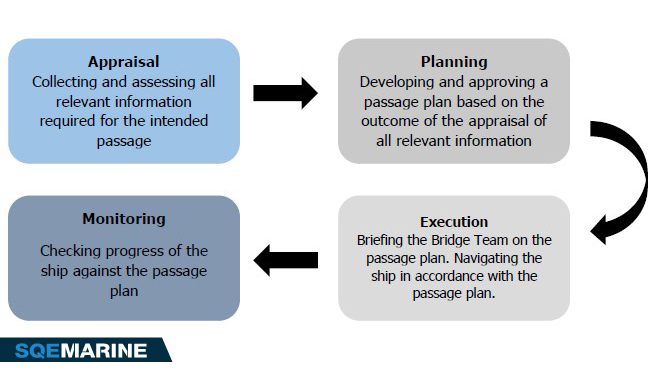Everyday mariners are planning deep sea voyages along major trade routes, sometimes under harsh weather conditions, ice hazards and other environmental features. This is another article in our Bridge Procedure Series, aiming to give bridge crews and shore based staff a greater understanding of an efficient passage planning across the busiest trade routes and new route additions.
What is passage planning?
A passage plan aims to develop a comprehensive berth to berth navigation plan in order to ensure safe voyage as it determines a route to be followed by:
- Recognizing the hazards, and assessing associated risks and decision points
- Checking the available depth of water and the sufficient sea room
- Fixing opportunities according to the appropriate position
- Reporting the relevant requirements and taking routing measures for ships
- Acting with respect to the anticipated traffic and weather conditions, and
- Complying with all applicable environmental protection measures
An experienced navigation officer, respecting the international legislation, prepares the vessel passage plan to be used by the bridge team.
[smlsubform prepend=”GET THE SAFETY4SEA IN YOUR INBOX!” showname=false emailtxt=”” emailholder=”Enter your email address” showsubmit=true submittxt=”Submit” jsthanks=false thankyou=”Thank you for subscribing to our mailing list”]
4 actual stages to be followed when preparing a passage plan
1st stage: Appraisal
Appraisal is the initial process during which the risks are identified and assessed, to ensure that the vessel passage plan is safe. Amongst the factors that should be considered during the appraisal of a passage plan is navigation, berthing requirements, mooring and tug operations, port entry requirements, security and anti-piracy measures, strength and stability, MARPOL Special Areas, national or regional requirements, passage plan amendments etc.
2nd stage: Planning
There should be undertaken a planning for any one section of the vessel passage plan using either all electronic or all paper charts rather than a mixture of chart types. Whether planning using paper chats or ECDIS, the plotting of the route should follow established conventions and include the pilotage phase, the ocean phase and coastal phase.
3rd stage: Execution
During this stage it is recommended that the Bridge Team get in touch with the passage plan and make sure that the ship would navigate in accordance with the developed plan. Moreover, there should be taken some actions, as long as the ship departs. Firstly, the speed should be adjusted based on the ETA and the expected weather and oceanographic conditions, in order to be on time at its port of destination. Additionally, there must be taken into account the availability of water and fuel on board, for the prevention of any shortage during the voyage. In case the ship uses ECDIS, there must be set the appropriate limits regarding the safety settings.
4th stage: Monitoring
It takes part throughout the voyage trying to check the position of the vessel, to ensure that it remains within the safe distance from any danger areas. The voyage is always safer when there is conducting a continuous monitoring of the ship’s progress along the pre-planned schedule. In case of any emergency situation, if the navigation officer feel it is necessary to deviate from plan, he should inform the master and take any action he think is better for both the ship and its crew. As in this stage of vessel passage plan all deck officers contribute their part in the plan, they must indicate personal characteristics such as good seamanship, experience and personal judgement.
The flowchart below, can help the interested parties understand and memorize better the passage planning procedure, by following the aforesaid stages:

Being familiar with passage plan
Master should thoroughly review each passage plan and provide corrective instructions, as may be necessary. All officers who will perform OOW duties during the voyage and will follow the approved passage plan should be informed, briefed and should sign the plan. A detailed briefing by Navigation officer prior departure should be performed with participation of master, Chief officer, OOWs and Bridge lookouts.
Items to be included in briefing:
- Passage plan in general
- No go/Dangerous areas
- Weather forecast
- Special instructions for costal navigation
- Main Engine use, speed and maneuvering details and restrictions
- Relevant Master standing orders
After each voyage a de-briefing meeting should be arranged with above mentioned participants in order to note experience and lessons learned for conducted voyage. This knowledge can be incorporated in future vessel passage planning.
The passage planning procedure can be supported by the use of a checklist, as the one provided by SQE MARINE here below.















































































Note the following to be included in Voyage/Passage planning.
In a long voyage some days may be very far away from Land. Master to confirm with Manager on arrangement of Helicopter or any other assistance require to attend to an emergency of a Crew on ship.
The Master to chaeck health condition of the crew. Some crew may be on medicated drugs for heart problems or for H.P
Do refer to the BPG, Nautical Institute Guide and MO RESOLUTION A.893(21) adopted on 25 November 1999
Guidelines For Voyage Planning: